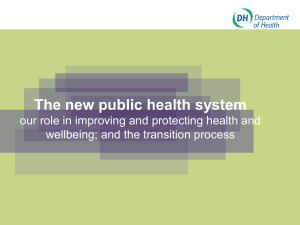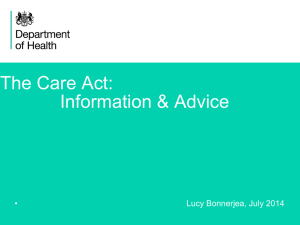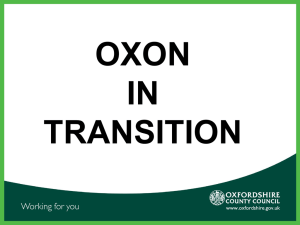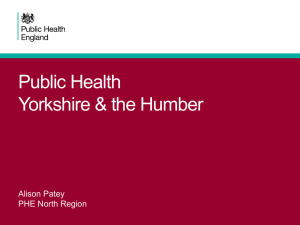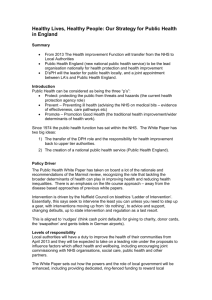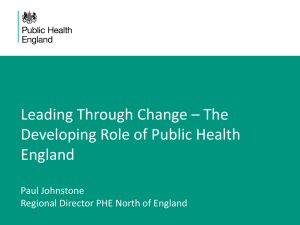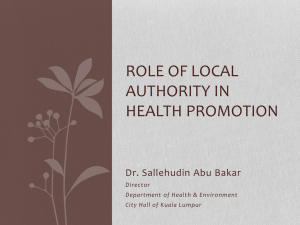Public Health- a Policy Briefing for the Voluntary
advertisement
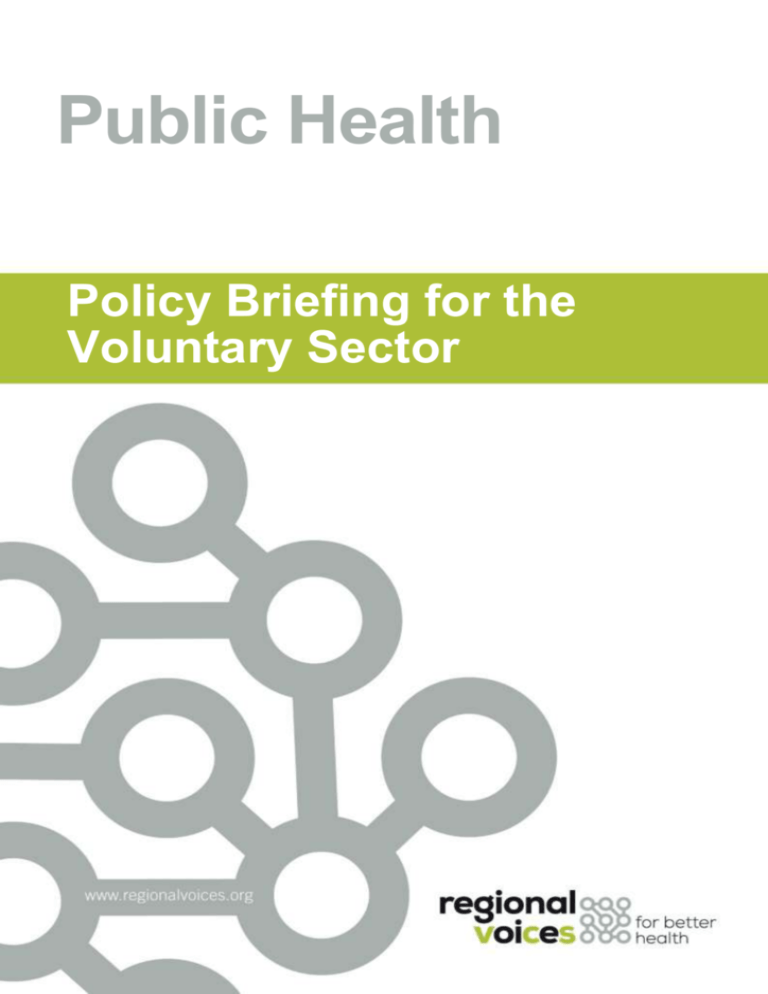
Public Health Policy Briefing for the Voluntary Sector 1 Briefing Aim: Provide a summary of the main developments in relation to public health. Explain the new public health system, whereby public health responsibilities are transferred to local government, supported by the newly created Public Health England. It includes a summary of the new public health outcomes framework, public health priorities for 2013/ 14 and how voluntary organisations can work with the new structures as partners in public health. Beverley Taylor June 2013 1. Overview of the New System In April 2013, most public health duties at a local level transferred to local government. This was based on the rationale that local authorities: have direct contact with many of their residents on a day to day basis. take a population approach, essential for public health. are well placed to try new ways to tackle public health problems have experience of the reality of health inequalities in their communities and many of the social determinants of health fall within their remit, enabling them to take strategic action to prevent inequalities in other areas such as housing, economic and environmental regeneration, strategic planning, education, children and young people’s services, fire and road safety. The vision is for local authorities to use their new responsibilities and resources to put health and wellbeing at the heart of everything they do, thereby helping people to lead healthier lives, both mentally and physically. To support local authorities and coordinate public health work throughout the country, Public Heath England was established on April 1st 2013. It is the lead national agency for public health. Regional Voices broadly supports the shift in responsibility for public health towards local authorities particularly as it recognises the impact of the wider determinants on health and the role of prevention in improving health and wellbeing. 2. The Role of Public Health England 2.1 Summary Public Health England (PHE) was established in April 2013 to promote the health and wellbeing of the nation, as the expert national public health agency with the statutory duty to protect health and address inequalities. It brought together staff from over 70 agencies, to form one national public health organisation. 2 Public Health England’s mission is to "work with national and local government, industry and the NHS to protect and improve the nation's health and support healthier choices. We are addressing inequality by focusing on removing barriers to good health". One of Public Health England’s main roles will be to ensure there are effective arrangements in place nationally and locally to prepare, plan and respond to health protection concerns and emergencies, including the future impact of climate change. PHE provides specialist health protection, epidemiology and microbiology across England. 2.2 Priorities In Our priorities for 2013/14 PHE identifies high level priorities and actions which it intends to discuss with partners over the coming months to refine thinking and to establish a three-year plan in the autumn of 2013: Helping people to live longer and healthier by reducing preventable deaths and the burden of ill health associated with smoking, poor blood pressure, obesity, poor diet, poor mental health, insufficient exercise and alcohol. Support the roll out and full implementation of NHS health checks to 15 million eligible people by local authorities. Support and accelerate national and local efforts to promote tobacco control and reduce the prevalence of smoking, based on evidence-based interventions. Develop a web-based reporting system on premature mortality and the public health outcomes framework to support local accountability for performance and improvement. Enable improved integration of care and support by supporting local innovation to find alternatives to hospital-based care especially for frail older people; share best practice on the contribution of prevention and early intervention to person centered care, and work with local areas pioneering approaches to integrating health, social care and healthcare public health to identify and tackle barriers. Reducing the burden of disease and disability by focusing on helping people to prevent or recover from the conditions with the greatest impact including dementia, anxiety, depression and drug dependency. Reduce the incidence and impact of dementia through implementing the Prime Minister’s challenge on dementia and work with partners to develop a coordinated national approach to prevention dementia including maximising the contribution of NHS Health checks and supporting dementia friendly communities. Improve recovery rates from drug dependency. Improve the performance of HIV and sexual health services and monitor and challenge new commissioning arrangements. 3 Develop a national programme of mental health in public health focused on No Health without Mental Health, promoting wellbeing, prevention and recovery. Protecting the country from infectious diseases and environmental hazards including the growing problem of infections that resist treatment with antibiotics. Reduce the rates of tuberculosis infections. Lead the gold standards for current and new vaccination and screening programmes such as measles, childhood flu and shingles. Tackle antimicrobial resistance (AMR) through national surveillance and strategy. Develop and implement a national surveillance strategy to ensure the public health system responds rapidly to new and unexpected threats to health. Supporting families to give children and young people the best start in life, through working with health visiting and school nursing family nurse partnerships. Launch a national programme promoting healthy weight and tackling childhood obesity, working with national and local partners to develop a multi-component approach. Partner the Troubled Families Programme. Accelerate improvements in child health outcomes through the continued development of key programmes for the 0-5s and work with the DH to secure transition to local authorities in 2015. Partner the early intervention foundation to develop the evidence base for early interventions and build support and commitment across the public health system and potential investors for evidence-based measures to improve outcomes for children and families. Improving health in the workplace by encouraging employers to support their staff and those moving in and out of the workforce to lead healthier lives. Support employers of all sizes and sectors to establish the business case and evidence base for supporting a healthy workforce. Build support for the Responsibility Deal in employers, and encourage more widespread adoption of the Responsibility Deal commitment to mental health adjustments in the workplace. Become a key exemplar of the aspirations in the Responsibility Deal by adopting measures to support a healthy and productive PHE workforce. 4 The five outcome-based priorities are underpinned by two operational priorities. Promote the development of place-based public health systems. Make the business case for promoting wellbeing, prevention and early intervention at the time of austerity for public services. Partner NHS England to maximise the NHSs impact on improving public health, ‘creating a joint narrative for health and wellbeing boards’, ensuring that health and care commissioning reflects national and local priorities, making the health needs of those overlooked on the margins visible, and working together on effective quality surveillance. Implement the public health workforce strategy and ensure the continued development of the public health workforce, including support for Making Every Contact Count. Ensure that data and information is used across the public health system to measure what is done, quantify benefits of the new public health system and demonstrate value for money. Develop capacity and capability in PHE to provide professional, scientific and delivery expertise to its partners. Establish and implement an organisational development strategy to develop a common PHE culture and values, and build capabilities needed to deliver priorities. Develop a research strategy that demonstrates academic excellence and value for money and identifies priorities for research aligned with current and future public health needs. Progress the business case for bringing together national expertise in epidemiology and microbiology into a single integrated national centre in Harlow. Review commercial activities and develop a commercial strategy to ensure maximum potential benefits including PHEs contribution to ‘UK plc’. 2.3 Structure of PHE Public Health England employs 5,500 staff, mostly scientists, researchers and public health professionals. Its' Chief Executive is Duncan Selbie, who produces a regular weekly briefing on the work of the agency. The agency is divided into 4 regions or 'hubs' (North of England, South of England, Midlands/ East and London), which map against NHS England regions and include the nine regional local government groupings. The regions will maintain an overview of progress on implementing the Public Health Outcomes Framework, nurturing the local public health system and developing the wider public health workforce. In addition there are 15 local centres across England, which will be the 'front door' of Public Health England and responsible for assuring that the services and expertise provided are focused on local needs. These local centres will: support local government in their leadership of the local public health system 5 support directors of public health across the range of their responsibilities enabling them to access specialised advice and support when required work with the NHS Commissioning Board to support it in its role as a direct commissioner of key services, including specialist services and national public health programmes provide leadership in responding to emergencies where scale is necessary. To support the local and regional work, there is a PHE National Executive and Directorate, responsible for developing and sharing knowledge, intelligence services, research, statistics and ‘know-how’. 3. Outcomes Framework The Public Health England priorities are based on a Public Health Outcomes Framework 201316, published by the Department of Health in January 2012. The aim of this framework is to guide all organisations involved in public health on priorities and measuring the impact of their work. PUBLIC HEALTH OUTCOMES FRAMEWORK OUTCOMES Vision: To improve and protect the nation’s health and wellbeing, and improve the health of the poorest fastest Outcome 1: Increased healthy life expectancy Taking account of the health quality as well as the length of life (Note: This measure uses a self-reported health assessment, applied to life expectancy.) Outcome 2: Reduced differences in life expectancy and healthy life expectancy between communities Through greater improvements in more disadvantaged communities (Note: These two measures would work as a package covering both morbidity and mortality, addressing within-area differences and between area differences) Domains DOMAIN 1: Improving the wider determinants of health Objective: Improvements against DOMAIN 2: Health improvement Objective: People are helped to live healthy lifestyles, make healthy DOMAIN 3: Health protection Objective: The population’s health is protected from DOMAIN 4: Healthcare public health and preventing premature mortality Objective: Reduced numbers of people 6 wider factors that affect health and wellbeing, and health inequalities choices and reduce health inequalities major incidents and other threats, while reducing health inequalities living with preventable ill health and people dying prematurely, while reducing the gap between communities Indicators (across the life course) Indicators (across the life course) Indicators (across the life course) Indicators (across the life course) The Outcomes Framework is divided into 3 main parts: Part 1 introduces the overarching vision for public health, the two higher level outcomes and four domains, each of which have indicators, to help measure improvements in public health. Part 2 specifies all the technical details for each public health indicator. Part 3 consists of the impact assessment and equalities impact assessment. 4. The Role of Local Authorities 4.1 Summary of the public health work transferred to local authorities Local authorities are now at the heart of the new public health system. Upper tier and unitary authorities have taken on new responsibilities to improve the health of their populations, backed by a ring-fenced grant and a specialist public health team, led by the Director of Public Health. Upper tier authorities will be supported in this by the existing expertise within district councils – around environmental health, for example. They will be expected to: embed health in all policies, to make 'reducing health inequalities' a major priority ensure resources are targeted at those in greatest need and represent best value for local people focus on preventing ill health and improving 'well being' work closely with the NHS encourage health promoting environments e.g. access to green space and transport support local communities to improve health through social networks and groups promote health protection and safer communities work with other partners through the local health and wellbeing board, prioritising needs, creating a joint strategic needs assessment, which summarises the main health priorities in a local area use the joint strategic needs assessment process to commission safe and quality services measure the impact of public health work in meeting the needs of vulnerable and disadvantaged groups, to ensure that the poorest health is improved fastest. 4.2 Commissioning In most cases, commissioning for public health has been devolved to local government. Local authorities will also need to work with clinical commissioning groups to provide integration across 7 clinical pathways. Local authorities are expected to commission (rather than directly provide) the majority of services. 4.3 The Director of Public Health The Director of Public Health will champion health across all local authority business and act as a key advocate for reducing health inequalities through all aspects of the authority's work. The Director will have a statutory place on the local health and wellbeing board and will take responsibility for all health work across the authority, reporting to the Chief Executive and working directly with elected members. In each local authority, the Director of Public Health will be required to produce a published annual report on the health of the local population. A key role for Directors of Public Health will be in responding to health protection incidents, such as the recent measles outbreak in Wales. They will support local authorities on preparing for emergencies. When services are commissioned, the Director of Public Health will ensure that clinical governance is sound, to ensure the safety of the work. 4.4 Core public health functions for local authorities From April 2013, local authorities have taken over the following public health functions: National Child Measurement Programme and other public health services for children and young people aged 5-19 NHS Health Checks for 15 million eligible men and women, aged 40-74 Provide public health advice to the NHS, especially on the commissioning of NHS services Sexual Health Commissioning, including STI testing and contraception. Abortion, sterilisation and vasectomy services will not be provided by local authorities. They will be the responsibility of clinical commissioning groups. HIV treatment will be commissioned by NHS England and contraception will also be provided by GPs, where it is part of the GP contract. Protect the health of their populations (including local plans for immunisation, screening, outbreaks and emergencies) Tobacco control and smoking cessation services Alcohol and drug misuse services Interventions to tackle obesity such as community lifestyle, nutrition and weight management services Public mental health services Dental public health services Accidental injury prevention Population level interventions to reduce and prevent birth defects Behavioural and lifestyle campaigns to prevent cancer and long-term conditions Local initiatives on workplace health Local initiatives to reduce excess deaths as a result of seasonal mortality Community safety and violence prevention Local initiatives to tackle social exclusion Local initiatives that reduce public health impacts of environmental risks This is not an exhaustive list. However, it summarises the main areas of public health work for local authorities. 8 5. Embedding the work of Voluntary and Community organisations in Public Health Early in his appointment, Duncan Selbie, Chief Executive of Public Health England identified a key role for the voluntary sector in public health... "We will work alongside the voluntary sector and do all we can to help get them “into the room” to co-design services that are integrated as well as, of course, delivering them." 2nd November 2012 Voluntary and community organisations need to work closely with Directors of Public Health, their local Healthwatch and voluntary sector representatives on health and wellbeing boards to ensure that the needs of their members and service users are properly reflected in joint strategic needs assessments and local health and wellbeing strategies. In commissioning services, local authorities are encouraged to adopt a diverse provider model, based on their experience of commissioning with a range of providers. In theory, this allows providers to compete within a faster and less bureaucratic process than traditional procurement by competitive tender. This should help voluntary and community organisations to develop innovative preventative work in promoting health and well-being, services that meet the needs of the most disadvantaged groups and reduce health inequalities. To find out more about Regional Voices' work in health, wellbeing and care go to http://www.regionalvoices.org/developments Follow us on twitter @regionalvoice Regional Voices connects voluntary and community organisations with government, through nine regional networks, to inform and influence policy at local, regional and national levels. Regional Voices is a Strategic Partner to the Department of Health, NHS Commissioning Board and Public Health England. If you require this information in an alternative format or further information email or call: contact@regionalvoices.org 0113 394 2300 9

